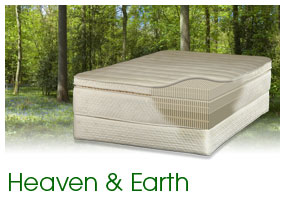Every purchase made online is encrypted with a high level of security you’ve come to expect. Your private information is never shared nor sold, so you can buy with confidence. You can also visit our store if you are in the St. Louis area.

Table of Contents
Organic Mattresses may be a better choice than organic food.
Recently I read a headline on yahoo’s homepage and later found it on the BBC which said that researchers at the London School of Hygiene and Tropical Diseases released the results of their study claiming organic food has no health or nutritional benefit over ordinary food. The article went on to say that the same results were found in 162 other studies over 50 year span. I don’t know about most people but personally I will keep planting my organic garden and eating my organic food where I know there is virtually no chemicals introduced. It gives me the satisfaction of knowing where my food comes from. A little know fact is that many organic foods are not only grown locally but also consumed locally which is great for local economies and means smaller carbon footprints.
Although one of the most popular choices today organic and healthy foods are just one aspect of healthy living. Only in recent years has it been brought to our attention that our homes are one of the most toxic environments we are exposed to. Even less know is that the mattresses we cuddle up to for an average 8 hours and the bedding we wrap ourselves into may pose the most risk from long term exposure.
So what’s in that mattress anyway?
The majority of mattresses built today consist of spun polyester fiber, chemically laden cotton, or processed wool. As many a known 60 chemicals can gas off and be inhaled from a mattress. Dangerous PBDE’s or Polybrominated diphenyl ethers, and phthalate plasticizers, are common in mattresses and can be inhaled causing numerous illnesses and diseases.
Non-organic cotton often touted as safe is loaded with dangerous herbicides and pesticides and to make things worse mattresses today are chemically treated with even more chemicals in the form of fire retardant chemicals to meet Federal Fire Code 1633, required as of July 2007 and mandated by the CPSC Consumer Product Safety Commission. Interestingly organic mattresses, which are naturally fire resistant and pass the federal burn requirements, have no chemically laden fire retardants.
Today natural latex rubber mattresses often use organic cotton and compressed wool in order to comply with the federal standards. Certified organic cotton and certified organic wool are also nearly free of dangerous chemicals and natural latex is one of the most no toxic chemicals mattress products built today. This is especially true when compared to conventional mattresses made of synthetic materials like polyurethane foam. Unfortunately many people think that if a bed or bedding was bad for us, the government would not allow us to sleep in it but that is just not the case. Lets face it have you ever seen a report that said formaldehyde or or phthalates often found in mattresses were good for you?
Can an organic mattress make a difference?
Don’t take our word for the next time you buy a mattress or bed linens do you homework and consider alternatives like organic mattresses and bedding. You may find a significant improvement in your health. People have often praised these products telling of fewer migraine headaches, cleared up rashes, and improved breathing due too less asthma symptoms.
We all spend 1/3 of your life in our bed so don’t take it lightly. Give it as much consideration or more as the organic foods you choose.
